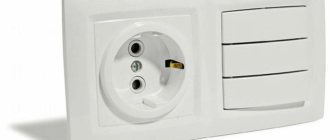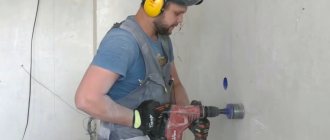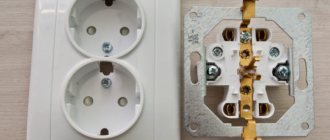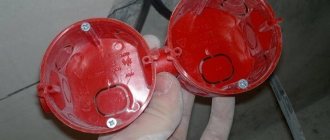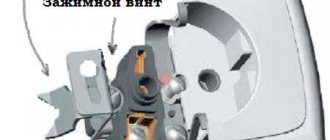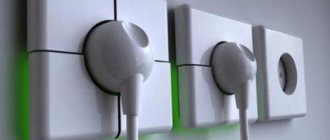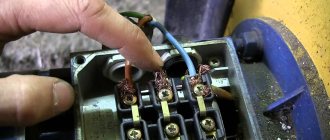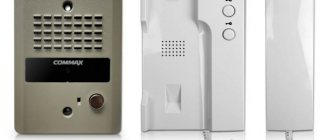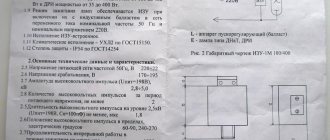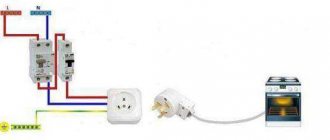Not so long ago, three-phase input to a consumer’s facility was considered the prerogative of industrial enterprises. Although, if you look in detail at the energy supply diagrams of apartment buildings, it turns out that residents receive the coveted 220 volts from the three-phase power supply panel. Surely, many of you have noticed that in the event of an accident on an electrical main, power may not be lost in the entire house at once, but as if in a checkerboard pattern. At the same time, in conversations among repairmen the phrase is heard: “the second phase has been knocked out...”.
This means that consumers in a high-rise building are distributed into three groups (usually with an even load). A three-phase power cable (four-core, excluding a separate working grounding bus) with a common meter and a single machine was installed at the facility. The output has 3 lines with a voltage of 380 volts between them, and a working zero. Next, in each of the three directions, a two-core power wire is laid (without taking into account the working grounding), on which the usual 220 volts are between phase and zero.
Since consumers in their apartment distribution panels have access to only one phase, such a power supply still does not apply to three-phase.
However, there are residential buildings (including apartment buildings) in which the entrance panel looks the same as in the previous illustration. For example, houses that do not have natural gas. Three-phase electric stoves are often installed in apartments. Three phases may be needed in rooms with an electric water heater or heating boiler. Such electrical equipment can also use three phases with a voltage of 380 volts.
What is high voltage power used for?
For the same reason that main power lines operate under a voltage of 10 thousand volts. To provide a certain load (power of an electrical appliance), there are two ways: increase the current strength at a reduced voltage, or vice versa: by increasing the voltage, you can reduce the current in the circuit. To save power cables, it is more rational to supply the consumer with 380 volts instead of 220.
The benefit is obvious: the current is lower, the wires heat up less, and their cross-section can be reduced. Likewise, switching devices are designed for lower current.
Accordingly, to connect the final electrical installations, there must be a three-phase socket in the room.
Important! If you have a 3-phase socket installed in your house, connecting powerful single-phase consumers to it without specially switching the input terminals is prohibited!
In this case, load imbalance occurs, this negatively affects the operation of generating devices and can damage the protective automation.
Electric installation work
We will not dwell in more detail on the preparation of documentation for connecting the power supply; this is a separate topic. Our task is to determine the materials and devices for external installation work, which, although they are an intermediate stage in the connection, are the most important, since they are related to human safety.
Single-phase or three-phase input?
For both three-phase and single-phase networks, the permitted power is indicated in the technical specifications. This can be 15 kW for both options, that is, the benefit of a three-phase network is not in power, but in the possibility of using an input cable of a smaller cross-section and reducing the load, since the current is distributed over 3 phases. Therefore, in a three-phase network, the rating of the input circuit breaker will be lower.
But the input distribution board will be increased in size, since the meter itself is larger than a single-phase one, and the circuit breakers occupy 3-4 modules. Three-phase RCDs also have larger dimensions. This is a disadvantage of three-phase input into the house, but it is not very significant compared to such advantages as the ability to connect asynchronous electric drives, electric boilers, heaters, and electric stoves in the house.
To avoid phase imbalance from powerful electrical receivers, the electrician-installer must distribute the load as evenly as possible. The operating voltage of a three-phase network is 380V, therefore, in order to eliminate the risk of fire and electric shock, it would be a good idea to install a three-pole additional circuit breaker right before entering the house. This prevents short circuits at the input.
External connection and electrical panel
When connecting a private house to the power supply, an air input is most often used (which is also indicated in the technical specifications) with the installation of an electricity metering cabinet (SHUE) to eliminate cases of electricity theft and problems with the commercial registration of electricity supply.
According to the standards, the input cable must have a cross-section of at least 16 mm2 if the core is aluminum, and 10 mm2 if the core is copper, at a distance from the support pole of 25 m. For a distance of less than 25 m, the cross-section of the aluminum wire is 10 mm2, copper - 4 mm2 .
If you have decided on the method of connection from the pole to the house (aerial or underground), as well as the type and cross-section of the cable, then it remains to figure out exactly how the wire is connected to the house, from where further wiring to the devices is made.
The wire cross-section is selected according to the PUE based on the long-term permissible current. For aerial input, the most common cable is VVG or VVGng (modern version), as well as cable AVVG and SIP (self-supporting wire). By the way, for underground input, VBBbShv or AVBbShv cable is most often used. As you already understand, the presence or absence of the letter “A” means an aluminum core.
The value of the cable cross-section and the long-term permissible current for it are taken from the PUE. The optimal cross-sections for the input cable are 10, 16, 25 mm2, with a maximum permissible current, respectively: 50, 70, 85A (for underground input), and 80, 100, 140A for air input. For example, to a copper wire with a cross-section of 10 mm2, you can connect a power of 15 kW for a voltage of 230 V and from 30 kW for a voltage of 380 V.
Types of three-phase sockets
Unlike single-phase, 3-phase sockets differ not only in the degree of protection and installation method.
- Protection can be from electric shock, as well as from dust and moisture. The IP** system determines how well the housing withstands the external environment. The first digit (dust) can be from 0 to 6, the second digit (moisture, water) from 0 to 9. That is, the IP-69 marking means the outlet is completely sealed.
- The number of connectors is determined by the method of connecting the consumer. A star circuit requires a minimum of 5 sockets. Three phases, working zero and protective grounding.
This is the most common scheme. The connector configuration has several standards set by the manufacturer. Sockets of this type must be purchased in pairs with a plug. Sockets and plugs of different brands may not fit together. This is what the five-pin kit from Legrand looks like:
When connecting according to the "triangle" scheme, a working zero is not needed. The socket will have 4 contacts: three phase and protective ground. The socket might look like this:or like this:
In addition, there are high-quality kits made according to GOST USSR, with in-line connectors.
Theoretically, such sockets can also operate in a star configuration, if the protective grounding is carried out along a separate line, bypassing the socket. But this is unsafe: there is no certainty that the ground is connected correctly.
The safest connection for a three-phase socket is 7 pins. This is an option for a star circuit, but each phase has its own protective ground. This method is gaining popularity in the European Union, but practical application for three-phase electrical installations is questionable.
- There are three main modifications according to the installation method:
- Three-phase socket for hidden installation. The mounting box is firmly mounted into the wall, the socket is installed flush.
Not to be confused with the concept of “triple socket for hidden installation”, in this case we are talking about a set of 3 single-phase sockets in one housing. - Overhead socket. Not the most convenient option for home installation: too bulky.
- For outdoor installation. Such kits usually have protection no lower than IP-67.
We correctly connect to the input device
First of all, let's deal with color coding. The power cable for three-phase connection may have European colors, or comply with the Electrical Installation Rules. In the first case, the phases are marked with brown, white (gray) and black shell colors. In the second - (which is unlikely for residential buildings), yellow, green and red. The cables have one thing in common: just like in a single-phase system, the working zero will be blue (blue), and the protective ground will be yellow with a green stripe along the length of the wire.
After the three-phase meter (electricity meter), a four-way automatic machine must be installed. It is on line 4: since both phases and zero must be turned off if necessary.
Important! The protective grounding is inserted into the socket without the possibility of it being broken by the switching device (automatic machine)!
In principle, the binding of specific lines to contact numbers is not defined by any instructions. Each user himself determines exactly how to connect a three-phase outlet.
According to unspoken rules, on a four-pin socket (for example), the working zero is located on the right.
And on the 5-pin (with protective grounding) in the center.
For an outdoor outlet protected from dust and moisture, there is also a standard line layout.
And yet, three-phase consumers are connected to the power point individually; there can be no universality. If you are commissioning an electric stove, there are several power supply options on the input connection block: 220 or 400 volts.
By default, jumpers may be installed that will lead to a short circuit between phases. Therefore, you should first study the instructions for the electrical installation, and then plan the location of the contacts in the outlet.
Installations with three-phase electric motors have their own power supply. Again, we return to the basic rule: no universality.
Conclusion
When starting such an important issue, you should prepare documents in advance, which usually takes up to 6 months. It is advisable to submit them in advance, even before the construction of the house begins. About two years will be allocated to fulfill these conditions. And of course, qualified employees should be involved in the work in order to further protect your home from fire.
One of the most important stages in the construction or renovation of a country house is its electrification. In modern housing, a large number of household appliances and all kinds of equipment are installed, and all these devices consume electricity. Therefore, we have to solve such an important issue as connecting the facility to the power grid. To do this, first of all, you will need a 380V, 15 kW power supply circuit for a private house, which can be of two types - single-phase and three-phase. Both options are in demand, but recently preference has been given to a three-phase circuit, which significantly reduces the load on the network due to its even distribution in the form of three parallel lines.
Checking phases using a multimeter
If you already have a socket, but you do not know the location of the lines on the contacts, you can easily determine their purpose, except for the phase numbers. This is done using a tester.
There should be a voltage of 380 volts between any phase contacts. Between the working zero and each of the phases there is 220 volts. A similar indicator will be obtained between protective grounding and phases. At the same time, it is quite difficult to determine where “zero” is and where “ground” is (in sockets with 5 contacts).
- If the power cable has a standard marking, you need to open the socket housing and make sure that the “ground” wire (of the appropriate color) is connected to the “correct” contact on one side, and the working ground bus on the other side (in the distribution panel).
- If it is impossible to identify the wire visually, we check the difference in potential for “zero” and “ground”.
Important! This method only works if the grounding is organized in accordance with the Electrical Installation Rules and does not have a physical connection with the working zero.
By the way, when combining “zero” and “ground”, the operation of electrical installations is generally prohibited.
The essence of the method: if you take measurements with a short interval, first between phase and “zero”, and then between phase and “ground”, in the second case the voltage will be slightly lower. This is due to the fact that the line between the protective ground and the phase passes through the physical ground (soil), where the resistance is higher than that of the neutral bus cable.
Single-line power supply diagram for a private house
When developing the power supply for private houses, a single-line diagram is most often used as the most optimal option. It allows for simple design and installation, even in-house. The single-line diagram has proven itself to be effective and easy to use. At its core, it is a highly simplified circuit diagram, where all types of connections and network laying are made with one line of the same thickness. This is where the name single-line diagram came from.
There are two options for single-line diagrams - calculation and executive. The first option is used in the process of building a house. This diagram determines the procedure for installing cable lines at a specific facility and the selection of protective equipment. Calculations of all power loads on this network are preliminarily performed. The calculated single-line diagram indicates all available powers and their values. The location of the ASU must be noted and electrical panels must be marked.
The executive diagram is carried out for existing electrical installations when the house has already been built. By this time, the results of a building survey have already been received from the design organization to prepare the most suitable location of all elements and power supply devices.
Installing an outlet
In principle, installation of any type (hidden, overhead) is not much different from a single-phase socket. However, there is an important feature:
In 3-phase power sockets, the number of contacts is greater than in conventional ones. The clamping force is significantly higher. Removing the plug will require more effort: if the fastening is not secure enough, there is a risk of simply tearing the socket out of the wall. Therefore, to install such products, reliable large-diameter dowels or anchor connections should be used.
When installing such an outlet on a plasterboard wall (without a supporting capital base), you should install a reinforcing plate with an area twice the diameter of the outlet.
When connecting wires to connectors, do not allow loose tightening or distortion of the fixing elements. If possible, the ends of the conductors must be prepared: tin or sleeve the stranded conductor, or install contact terminals.
If these requirements are not met, a voltage drop may occur in one of the phases (due to poor contact), which can lead to failure of the electrical installation.
